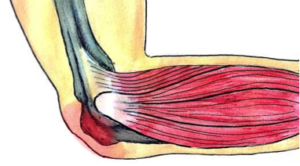CUMBERLAND PHYSIOTHERAPY PARRAMATTA:
What is it?
Bursae are small sacs of fluid found throughout the body. These bursae produce synovial fluid and act to reduce friction between muscles, tendons, ligaments and bones as they move over each other. Bursae are located at strategic points, typically where there are higher points of stress. If a bursa is injured or irritated, it can become inflamed, painful, red and swollen and this condition is referred to as bursitis.
One bursa that is commonly affected is the olecranon bursa, which sits just over the hard bony process at the base of the elbow. Olecranon bursitis refers to inflammation of the bursa at this point and is a common condition, particularly in men between the ages of 30-60.
What causes it?
Olecranon bursitis has a few different causes including trauma, overuse and infection. A sharp blow to the elbow, through a fall or hit, might damage the bursa leading to bursitis. In other cases, the bursa can be infected by bacteria, which enter the body through a small skin tear. Bursitis can also develop slowly through friction of the nearby muscles that cause the bursa to become irritated and inflamed.
What are the symptoms?
The hallmark of this condition is a painful, red, swollen elbow. Typically pain is worst when resting on the tip of the elbow and/or with elbow movements, particularly when bending or straightening the elbow fully. The pain often lasts a few months and may not go away on its own. The pain may build up gradually, or come on suddenly, depending on the cause. Bursitis caused by infection (septic bursitis) may also be associated with general feelings of illness such as fatigue, fever and body aches.
What is the treatment?
As there are many different causes of this condition, accurate diagnosis is essential. Your physiotherapist is able to distinguish between olecranon bursitis and similar conditions such as rheumatoid arthritis or fibromyalgia. Septic bursitis will need to be treated by a medical professional who will determine the best course of action. All types of bursitis can be managed initially with a RICE protocol to reduce pain and swelling (Rest, ice, compression and elevation). Mechanical causes of bursitis can require more in-depth identification of the factors that may have led to the development of this condition.
Your physiotherapist is able to address these factors plus provide taping support to unload the bursa along with manual therapy and an exercise program. If this is unsuccessful, cortisone injections are often used to reduce pain and inflammation. In severe cases where the pain persists despite all other attempts at treatment, the bursa can be surgically removed in a procedure called a bursectomy. Once the pain has subsided your physiotherapist is also able to help prevent any further recurrence.
None of the information in this article is a replacement for proper medical advice. Always see a medical professional for advice on your individual injury.

